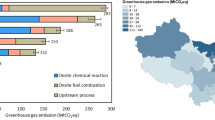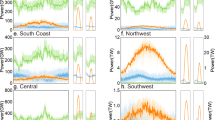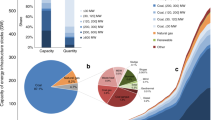Abstract
China needs to manage its coal-dominated power system to curb carbon emissions, as well as to address local environmental priorities such as air pollution and water stress. Here we examine three province-level scenarios for 2030 that represent various electricity demand and low-carbon infrastructure development pathways. For each scenario, we optimize coal power generation strategies to minimize the sum of national total coal power generation cost, inter-regional transmission cost and air pollution and water costs. We consider existing environmental regulations on coal power plants, as well as varying prices for air pollutant emissions and water to monetize the environmental costs. Comparing 2030 to 2015, we find lower CO2 emissions only in the scenarios with substantial renewable generation or low projected electricity demand. Meanwhile, in all three 2030 scenarios, we observe lower air pollution and water impacts than were recorded in 2015 when current regulations and prices for air pollutant emissions and water are imposed on coal power plants. Increasing the price of air pollutant emissions or water alone can lead to a tradeoff between these two objectives, mainly driven by differences between air pollution-oriented and water-oriented transmission system designs that influence where coal power plants will be built and retired.
This is a preview of subscription content, access via your institution
Access options
Access Nature and 54 other Nature Portfolio journals
Get Nature+, our best-value online-access subscription
$29.99 / 30 days
cancel any time
Subscribe to this journal
Receive 12 digital issues and online access to articles
$119.00 per year
only $9.92 per issue
Buy this article
- Purchase on Springer Link
- Instant access to full article PDF
Prices may be subject to local taxes which are calculated during checkout





Similar content being viewed by others
Data availability
Data used to perform this study can be found in the Supplementary Information. Any further data that support the findings of this study are available from the corresponding authors upon request.
References
Markandya, A. et al. Public health benefits of strategies to reduce greenhouse-gas emissions: low-carbon electricity generation. Lancet 374, 2006–2015 (2009).
Buonocore, J. J. et al. Health and climate benefits of different energy-efficiency and renewable energy choices. Nat. Clim. Change 6, 100 (2015).
Plachinski, S. D. et al. Quantifying the emissions and air quality co-benefits of lower-carbon electricity production. Atmos. Environ. 94, 180–191 (2014).
Yang, J., Li, X., Peng, W., Wagner, F. & Mauzerall, D. L. Climate, air quality and human health benefits of various solar photovoltaic deployment scenarios in China in 2030. Environ. Res. Lett. 13, 064002 (2018).
Macknick, J., Sattler, S., Averyt, K., Clemmer, S. & Rogers, J. The water implications of generating electricity: water use across the United States based on different electricity pathways through 2050. Environ. Res. Lett. 7, 045803 (2012).
Hejazi, M. I. et al. 21st century United States emissions mitigation could increase water stress more than the climate change it is mitigating. Proc. Natl Acad. Sci. USA 112, 10635 (2015).
Clemmer, S., Rogers, J., Sattler, S., Macknick, J. & Mai, T. Modeling low-carbon US electricity futures to explore impacts on national and regional water use. Environ. Res. Lett. 8, 015004 (2013).
Huang, W., Ma, D. & Chen, W. Connecting water and energy: assessing the impacts of carbon and water constraints on China’s power sector. Appl. Energy 185, 1497–1505 (2017).
Webster, M., Donohoo, P. & Palmintier, B. Water–CO2 trade-offs in electricity generation planning. Nat. Clim. Change 3, 1029 (2013).
Zhai, H., Rubin, E. S. & Versteeg, P. L. Water use at pulverized coal power plants with postcombustion carbon capture and storage. Environ. Sci. Technol. 45, 2479–2485 (2011).
Peng, W. et al. Air quality and climate benefits of long-distance electricity transmission in China. Environ. Res. Lett. 12, 064012 (2017).
Pacsi, A. P., Alhajeri, N. S., Webster, M. D., Webber, M. E. & Allen, D. T. Changing the spatial location of electricity generation to increase water availability in areas with drought: a feasibility study and quantification of air quality impacts in Texas. Environ. Res. Lett. 8, 035029 (2013).
Janssens-Maenhout, G. et al. EDGARv4.3. 2 Global atlas of the three major greenhouse gas emissions for the period 1970–2012. Earth Syst. Sci. Data Discuss. 2017, 1–55 (2017)..
Ambient Air Pollution: A Global Assessment of Exposure and Burden of Disease (World Health Organization, 2016).
Brauer, M. et al. Ambient air pollution exposure estimation for the global burden of disease 2013. Environ. Sci. Technol. 50, 79–88 (2016).
Baseline Water Stress: China Technical Note (World Resources Institute, Bejing, 2016).
Tracking Clean Energy Progress 2017 (International Energy Agency, Paris, 2017).
National Action Plan on Prevention and Control Air Pollution (State Council, Bejing, 2013).
13th Five-Year Plan for Eco-Environmental Protection (State Council, Bejing, 2016).
World Energy Outlook 2017 (International Energy Agency, Paris, 2017).
China Renewable Energy Outlook 2017 (Energy Research Institute of the Academy of Macroeconomic Research, National Development and Reform Commission & China National Renewable Energy Centre, 2017).
International Energy Outlook 2017 (US Energy Information Administration, 2017).
King, A. & Ramana, M. V. The China syndrome? Nuclear power growth and safety after Fukushima. Asian Perspect. 39, 607–636 (2015).
Satoh, Y. et al. Multi-model and multi-scenario assessments of Asian water futures: the Water Futures and Solutions (WFaS) initiative. Earths Future 5, 823–852 (2017).
Announcement on Requirements of Coal-Fired Power Plants Planning and Construction (National Development and Reform Commission, Bejing, 2004).
Announcement on Adjusting Pollution Tax (National Development and Reform Commission, Bejing, 2014).
2014 Water Tariff Survey (Global Water Intelligence, Austin, 2014).
Qin, Y. et al. Air quality–carbon–water synergies and trade-offs in China’s natural gas industry. Nat. Sustain. 1, 505–511 (2018).
India Water Tool (World Resources Institute, Bejing, 2015).
Muller, N. Z. & Mendelsohn, R. Measuring the damages of air pollution in the United States. J. Environ. Econ. Manag. 54, 1–14 (2007).
Peng, W., Yang, J., Lu, X. & Mauzerall, D. L. Potential co-benefits of electrification for air quality, health, and CO2 mitigation in 2030 China. Appl. Energy 218, 511–519 (2018).
Liu, L., Hejazi, M., Li, H., Forman, B. & Zhang, X. Vulnerability of US thermoelectric power generation to climate change when incorporating state-level environmental regulations. Nat. Energy 2, 17109 (2017).
van Vliet, M. T. H. et al. Multi-model assessment of global hydropower and cooling water discharge potential under climate change. Glob. Environ. Change. 40, 156–170 (2016).
van Vliet, M. T. H., Wiberg, D., Leduc, S. & Riahi, K. Power-generation system vulnerability and adaptation to changes in climate and water resources. Nat. Clim. Change 6, 375 (2016).
He, G. et al. SWITCH-China: a systems approach to decarbonizing China’s power system. Environ. Sci. Technol. 50, 5467–5473 (2016).
Blair, N., Zhou, E., Getman, D. & Arent, D. J. Electricity Capacity Expansion Modeling, Analysis, and Visualization: a Summary of Selected High-Renewable Modeling Experiences Technical Report NREL/TP-6A20-64831 (National Renewable Energy Laboratory, 2015).
Xia, J. et al. Vulnerability of and risk to water resources in arid and semi-arid regions of West China under a scenario of climate change. Clim. Change 144, 549–563 (2017).
Haddeland, I. et al. Global water resources affected by human interventions and climate change. Proc. Natl Acad. Sci. USA 111, 3251 (2014).
China Electric Power Statistical Yearbook 2016 (China Statistics Press, 2016).
Shearer, C., Mathew-Shah, N., Myllyvirta, L., Yu, A. & Nace, T. Boom and Bust 2018: Tracking the Global Coal Plant Pipeline (CoalSwarm, Sierra Club, San Francisco, 2018).
ECLIPSE V5a Global emission fields (International Institute for Applied Systems Analysis, 2015); http://www.iiasa.ac.at/web/home/research/researchPrograms/air/ECLIPSEv5a.html
Liao, X., Hall, J. W. & Eyre, N. Water use in China’s thermoelectric power sector. Glob. Environ. Change. 41, 142–152 (2016).
Integrated Environmental Control Model v.9.0.1 (Carnegie Mellon University, Pittsburgh, 2014); https://www.cmu.edu/epp/iecm/index.html
Davidson, M. R., Zhang, D., Xiong, W., Zhang, X. & Karplus, V. J. Modelling the potential for wind energy integration on China’s coal-heavy electricity grid. Nat. Energy 1, 16086 (2016).
Announcement On Improving The Pricing System For Inter-regional And Inter-provincial Electricity Trade (National Development and Reform Commission, Beijing, 2015).
Macknick, J., Newmark, R., Heath, G. & Hallett, K. C. Operational water consumption and withdrawal factors for electricity generating technologies: a review of existing literature. Environ. Res. Lett. 7, 045802 (2012).
Feng, K., Hubacek, K., Pfister, S., Yu, Y. & Sun, L. Virtual scarce water in China. Environ. Sci. Technol. 48, 7704–7713 (2014).
Pfister, S., Koehler, A. & Hellweg, S. Assessing the environmental impacts of freshwater consumption in LCA. Environ. Sci. Technol. 43, 4098–4104 (2009).
Acknowledgements
W.P. thanks the Woodrow Wilson School of Public and International Affairs at Princeton University for her graduate fellowship and the J.F. Kennedy School of Government at Harvard University for postdoctoral fellowship. C.D. acknowledges the funding support of the UK Natural Environment Research Council Fellowship (grant no. NERC NE/N01524X/1). We thank Y. Satoh for sharing water availability data, and K. Feng, L. Liu and X. He for valuable suggestions.
Author information
Authors and Affiliations
Contributions
W.P., F.W. and D.L.M. designed the study. W.P. performed the research. F.W., M.V.R., H.Z, M.J.S., C.D. and X.Z. contributed data and analysis tools. W.P. and D.L.M wrote the initial manuscript and all authors contributed to subsequent revisions.
Corresponding author
Ethics declarations
Competing interests
The authors declare no competing interests.
Additional information
Publisher’s note: Springer Nature remains neutral with regard to jurisdictional claims in published maps and institutional affiliations.
Supplementary information
Supplementary Information
Supplementary Notes 1–5, Supplementary Tables 1–10, Supplementary Figures 1–16, Supplementary References 1–25
Rights and permissions
About this article
Cite this article
Peng, W., Wagner, F., Ramana, M.V. et al. Managing China’s coal power plants to address multiple environmental objectives. Nat Sustain 1, 693–701 (2018). https://doi.org/10.1038/s41893-018-0174-1
Received:
Accepted:
Published:
Issue Date:
DOI: https://doi.org/10.1038/s41893-018-0174-1
This article is cited by
-
Cost-effectiveness uncertainty may bias the decision of coal power transitions in China
Nature Communications (2024)
-
Decarbonization efforts hindered by China’s slow progress on electricity market reforms
Nature Sustainability (2023)
-
U.S. West Coast droughts and heat waves exacerbate pollution inequality and can evade emission control policies
Nature Communications (2023)
-
Carbon emissions of 5G mobile networks in China
Nature Sustainability (2023)
-
Reducing environmental impacts through socioeconomic transitions: critical review and prospects
Frontiers of Environmental Science & Engineering (2023)



